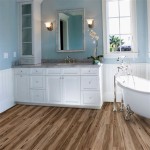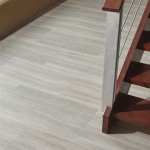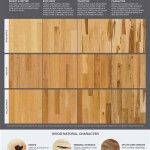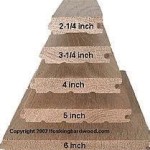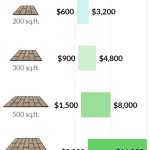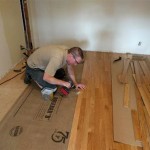How To Fix Deep Scratches On Laminate Flooring
Laminate flooring, while known for its durability and affordability, is not impervious to damage. Scratches, especially deep ones, can mar its appearance and detract from the overall aesthetic of a room. Addressing these deep scratches effectively requires a methodical approach and the right tools. Ignoring them can potentially lead to further damage, such as moisture penetration and eventual swelling of the core layers.
This article provides a comprehensive guide on how to repair deep scratches on laminate flooring. The methods described aim to restore the floor's original appearance or, at the very least, minimize the visibility of the damage.
Assessing the Damage and Gathering Necessary Materials
Before attempting any repair, a thorough assessment of the scratch is crucial. Determine the depth, length, and width of the scratch, as well as the color and pattern of the laminate flooring. This assessment dictates the appropriate repair method and the specific materials required.
For deep scratches, the following materials are generally needed:
*Laminate Floor Repair Kit:
These kits typically include a range of colored fillers, a heating tool (often a wax melting tool), and tools for application and leveling. Ensure the kit includes colors that closely match the flooring. *Putty Knife or Scraper:
A flexible putty knife or scraper is essential for applying and smoothing the filler. *Soft Cloth:
Clean, soft cloths are used for wiping away excess filler and buffing the repaired area. *Vacuum Cleaner:
A vacuum cleaner is necessary to remove debris from the scratch before and after repair. *Painter's Tape:
Painter's tape can be used to protect the surrounding flooring during the repair process. *Color Matching Chart (Provided in Repair Kit):
A color matching guide will help to mix and match to achieve the best possible result. *Safety Glasses:
Protect your eyes from debris and potential splashes. *Gloves:
Protect your hands from fillers and chemicals.The depth of the scratch is a primary factor in determining the method. A scratch that penetrates the decorative layer and reaches the core of the laminate constitutes a deep scratch requiring filler.
Preparing the Damaged Area
Proper preparation of the damaged area is paramount for a successful repair. This involves cleaning the scratch and its surrounding area to ensure proper adhesion of the filler. The aim is to remove any dirt, dust, or debris that could compromise the repair.
Begin by thoroughly vacuuming the scratch and the immediate surrounding area. Use the crevice tool of the vacuum to effectively remove any debris lodged within the scratch. Avoid using excessive force, as this could potentially widen the scratch.
Next, clean the area with a slightly damp cloth. Use a mild detergent if necessary, but ensure the area is thoroughly dried afterwards. Avoid using excessive water, as this could seep into the core of the laminate and cause swelling. Allow the area to air dry completely before proceeding to the next step.
If desired, apply painter's tape around the scratch to protect the surrounding flooring. This can prevent accidental application of filler to unintended areas. Ensure the tape is firmly affixed to the floor to prevent filler from seeping underneath.
Applying and Blending the Filler
This stage requires patience and attention to detail. The goal is to fill the scratch completely with the filler, matching the color and pattern of the surrounding laminate as closely as possible.
Using the color matching chart provided in the repair kit, select the appropriate filler color(s) or mix colors to achieve a close match to the flooring. Most kits include a melting tool which heats up the sticks of colored wax. Carefully melt the selected color and drip a small amount of the melted filler into the scratch. It is better to apply too little than too much.
Use the putty knife or scraper to gently press the filler into the scratch, ensuring it completely fills the void. Avoid applying excessive pressure, as this could damage the surrounding flooring. Work in small sections, gradually filling the entire length of the scratch.
Once the scratch is filled, use the putty knife or scraper to remove any excess filler. Hold the putty knife at a slight angle and gently scrape away the excess, ensuring the filler is flush with the surface of the flooring. Wipe the putty knife clean after each pass to prevent smearing.
Some repair kits may include a graining tool. If this is the case, use it to replicate the grain pattern of the laminate on the filled area. This can help to further blend the repair with the surrounding flooring. Follow the manufacturer's instructions for using the graining tool.
Allow the filler to dry completely according to the manufacturer's instructions. This may take several hours or even overnight. Avoid walking on the repaired area until the filler is fully dry.
Finishing and Buffing the Repaired Area
After the filler has dried, the final step is to refine the repair and blend it seamlessly with the surrounding flooring. This involves carefully buffing the repaired area to remove any remaining imperfections and to create a uniform sheen.
Use a clean, soft cloth to gently buff the repaired area. Apply light pressure and use a circular motion. The goal is to remove any remaining residue from the filler and to smooth out any rough edges. Avoid using excessive force, as this could damage the repaired area or the surrounding flooring.
If the repaired area appears too shiny, you can use a very fine-grit sandpaper (e.g., 400-grit or higher) to gently dull the shine. Use extreme caution when using sandpaper, as it can easily scratch the surrounding flooring. Apply very light pressure and use a circular motion. Afterwards, buff the area again with a clean, soft cloth.
Inspect the repaired area carefully. If necessary, repeat the filling, blending, and buffing steps to achieve the desired result. The goal is to make the repair as invisible as possible. However, it is important to acknowledge that a perfect repair may not always be possible, especially with deep scratches.
Remove the painter's tape, if used. Clean the repaired area and the surrounding flooring with a damp cloth to remove any remaining dust or debris.
Alternative Methods and Considerations
While laminate floor repair kits are the most common and effective solution for deep scratches, alternative methods may be considered in certain circumstances. The choice of method depends on the severity of the scratch, the available materials, and the desired outcome.
Colored Pencils or Markers:
For very minor scratches, colored pencils or markers specifically designed for wood or laminate can be used to conceal the damage. Select a color that closely matches the flooring and carefully fill in the scratch. Wipe away any excess with a clean cloth. This method is suitable for superficial scratches only and is unlikely to be effective for deep scratches.Furniture Polish or Wax:
Applying a thin layer of furniture polish or wax can help to reduce the visibility of minor scratches. This method works by filling in the scratch and creating a more uniform surface sheen. Apply the polish or wax according to the manufacturer's instructions and buff the area with a clean cloth. This method is best suited for scratches that are primarily affecting the surface sheen of the flooring.Professional Repair:
For very deep or extensive scratches, or if you are uncomfortable performing the repair yourself, it is best to consult a professional flooring contractor. A professional may have access to specialized tools and techniques that can provide a more seamless repair. This is generally the most expensive option, but it can be the most effective for complex or challenging repairs.When selecting a repair method, consider the following factors:
*The extent of the damage:
Deeper scratches require more extensive repair methods. *The color and pattern of the flooring:
Matching the color and pattern is crucial for a seamless repair. *Your skill level:
Choose a method that you are comfortable performing. *Your budget:
Professional repairs can be costly. *The location of the scratch:
Scratches in high-traffic areas may require more durable repairs.Regular maintenance, such as sweeping and vacuuming, can help to prevent scratches from occurring in the first place. Using floor protectors under furniture legs can also help to minimize the risk of damage. By taking proactive measures, you can extend the life of your laminate flooring and maintain its appearance for years to come.

How To Fix Scratches On Laminate Flooring

3 Ways To Repair Laminate Floor Scratches Wikihow

How To Fix Scratches On Laminate Flooring Episode 6 Howtospecialist Build Step By Diy Plans

7 Tips To Help Prevent Scratches On Wood Floors Flooring

How To Repair Laminate Flooring The Home Depot

How To Fix Scratches On Hardwood Floors Twenty Oak

Deep Scratches On Hardware Floors And Covering Multiple Boards Hometalk

Shallow Scratches Deep And Everything In Between Hardwood Floor Refinishing Services Highland Park Plus Flooring

3 Diy Way To Fix A Scratch In Hardwood Floors 5 Steps With S Instructables

5 Fix For Laminate Lvp Flooring Chips Scratches
Related Posts


